Employee Relations Report: Employee Voice and Organizational Success
VerifiedAdded on 2020/01/07
|10
|3445
|159
Report
AI Summary
This report provides a comprehensive overview of employee relations, examining different management perspectives such as unitary and pluralistic approaches, and their impact on employee development and team dynamics. It delves into the formation and significance of psychological contracts, emphasizing the importance of trust, communication, and equitable treatment in fostering positive employee relationships and boosting performance. The report also explores employee voice in both unionized and non-unionized contexts, highlighting how these systems can improve organizational performance by providing platforms for consultation, collective bargaining, and individual expression. Furthermore, the report evaluates the role of employee engagement, illustrated by an evaluation of McDonald’s approach, and its impact on organizational success. The report concludes by summarizing the importance of employee voice and its multifaceted benefits to an organization.
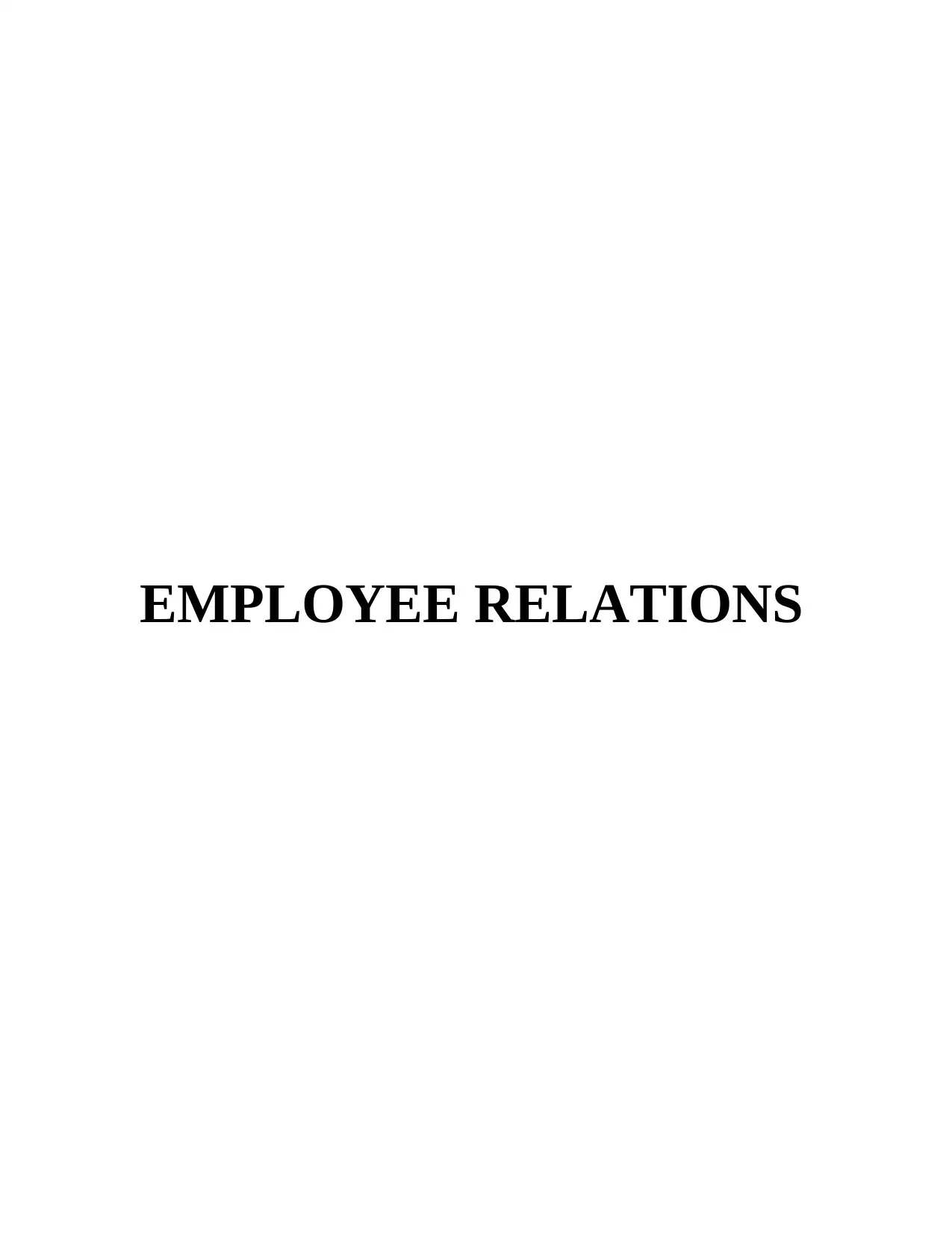
EMPLOYEE RELATIONS
Paraphrase This Document
Need a fresh take? Get an instant paraphrase of this document with our AI Paraphraser
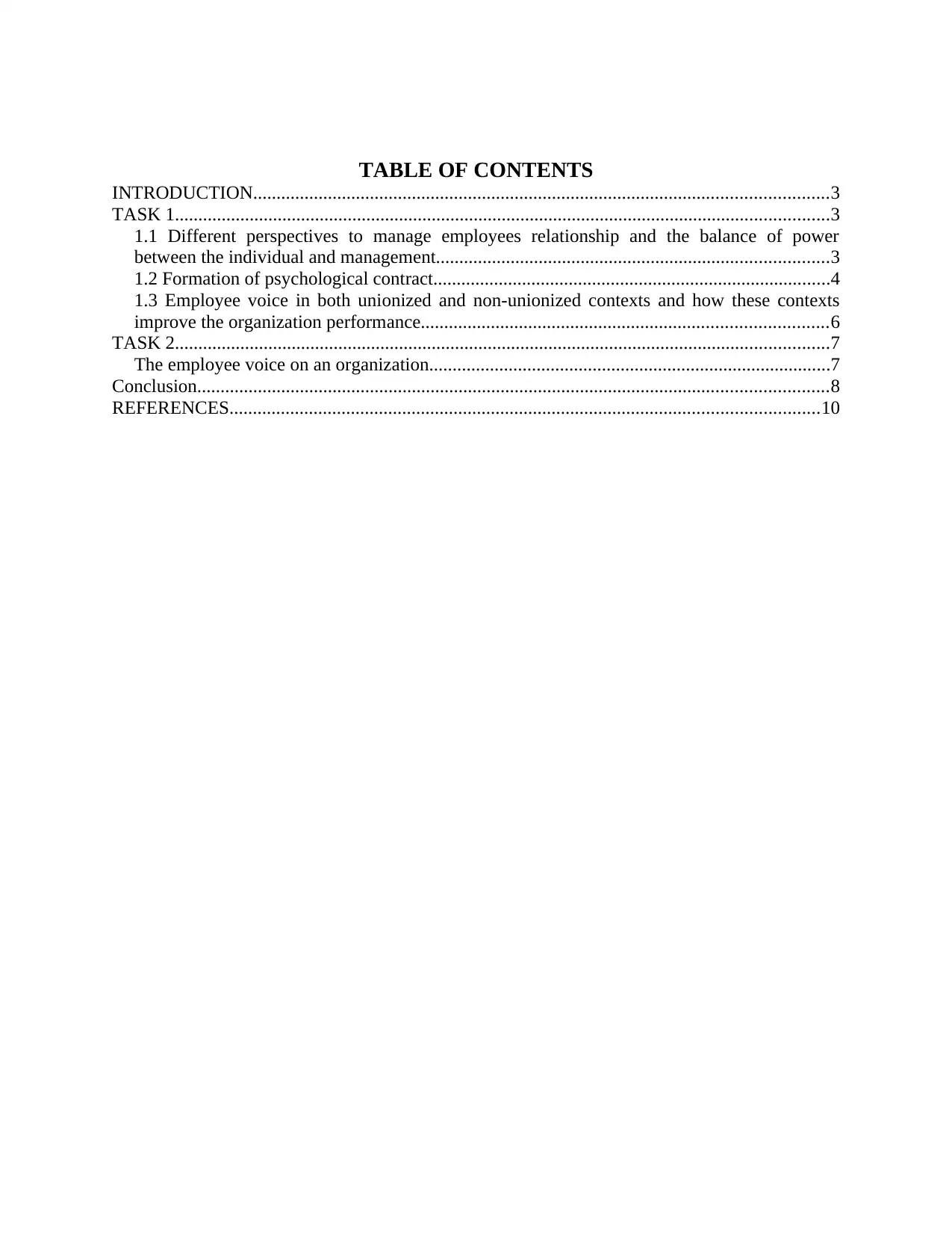
TABLE OF CONTENTS
INTRODUCTION...........................................................................................................................3
TASK 1............................................................................................................................................3
1.1 Different perspectives to manage employees relationship and the balance of power
between the individual and management....................................................................................3
1.2 Formation of psychological contract.....................................................................................4
1.3 Employee voice in both unionized and non-unionized contexts and how these contexts
improve the organization performance.......................................................................................6
TASK 2............................................................................................................................................7
The employee voice on an organization......................................................................................7
Conclusion.......................................................................................................................................8
REFERENCES..............................................................................................................................10
INTRODUCTION...........................................................................................................................3
TASK 1............................................................................................................................................3
1.1 Different perspectives to manage employees relationship and the balance of power
between the individual and management....................................................................................3
1.2 Formation of psychological contract.....................................................................................4
1.3 Employee voice in both unionized and non-unionized contexts and how these contexts
improve the organization performance.......................................................................................6
TASK 2............................................................................................................................................7
The employee voice on an organization......................................................................................7
Conclusion.......................................................................................................................................8
REFERENCES..............................................................................................................................10
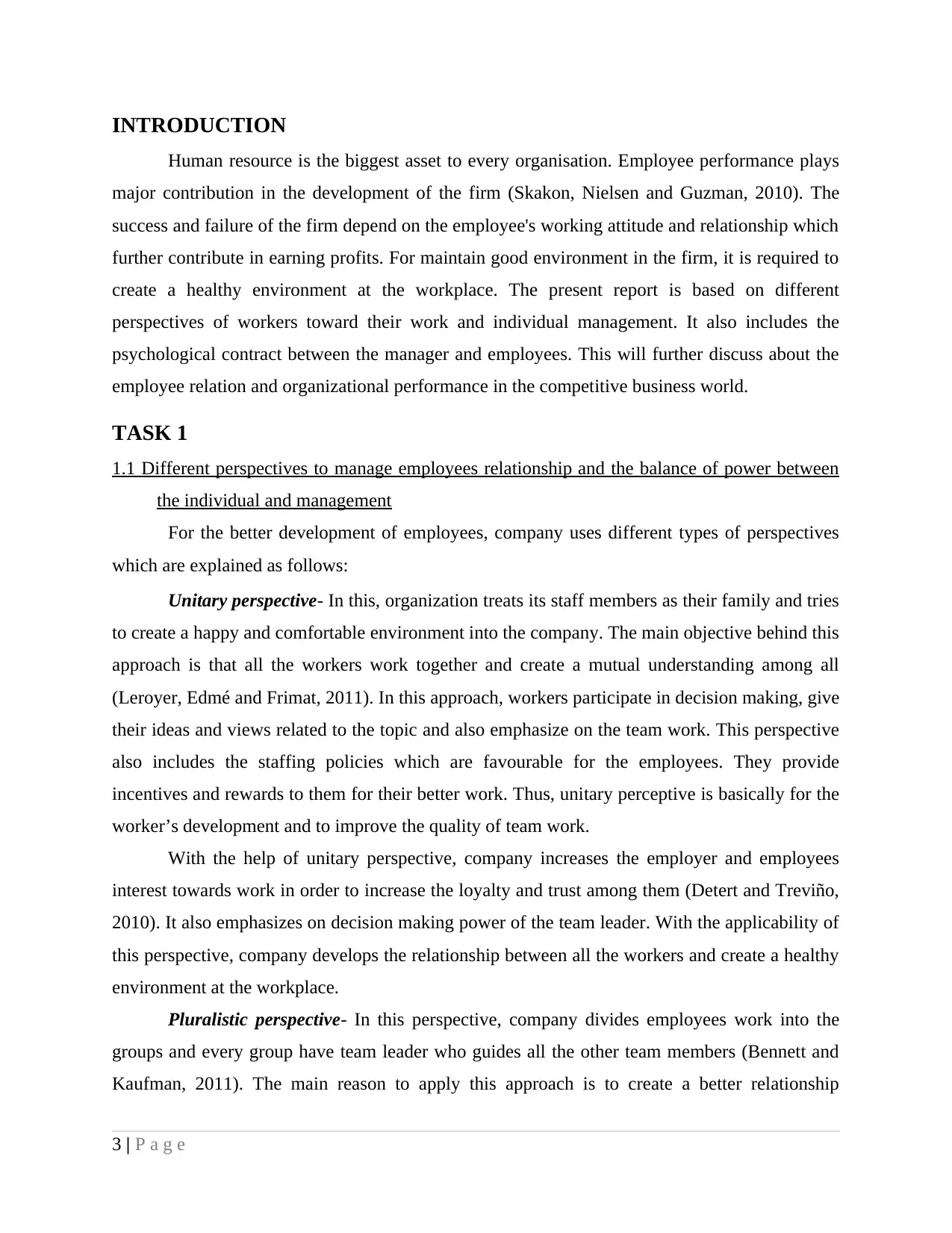
INTRODUCTION
Human resource is the biggest asset to every organisation. Employee performance plays
major contribution in the development of the firm (Skakon, Nielsen and Guzman, 2010). The
success and failure of the firm depend on the employee's working attitude and relationship which
further contribute in earning profits. For maintain good environment in the firm, it is required to
create a healthy environment at the workplace. The present report is based on different
perspectives of workers toward their work and individual management. It also includes the
psychological contract between the manager and employees. This will further discuss about the
employee relation and organizational performance in the competitive business world.
TASK 1
1.1 Different perspectives to manage employees relationship and the balance of power between
the individual and management
For the better development of employees, company uses different types of perspectives
which are explained as follows:
Unitary perspective- In this, organization treats its staff members as their family and tries
to create a happy and comfortable environment into the company. The main objective behind this
approach is that all the workers work together and create a mutual understanding among all
(Leroyer, Edmé and Frimat, 2011). In this approach, workers participate in decision making, give
their ideas and views related to the topic and also emphasize on the team work. This perspective
also includes the staffing policies which are favourable for the employees. They provide
incentives and rewards to them for their better work. Thus, unitary perceptive is basically for the
worker’s development and to improve the quality of team work.
With the help of unitary perspective, company increases the employer and employees
interest towards work in order to increase the loyalty and trust among them (Detert and Treviño,
2010). It also emphasizes on decision making power of the team leader. With the applicability of
this perspective, company develops the relationship between all the workers and create a healthy
environment at the workplace.
Pluralistic perspective- In this perspective, company divides employees work into the
groups and every group have team leader who guides all the other team members (Bennett and
Kaufman, 2011). The main reason to apply this approach is to create a better relationship
3 | P a g e
Human resource is the biggest asset to every organisation. Employee performance plays
major contribution in the development of the firm (Skakon, Nielsen and Guzman, 2010). The
success and failure of the firm depend on the employee's working attitude and relationship which
further contribute in earning profits. For maintain good environment in the firm, it is required to
create a healthy environment at the workplace. The present report is based on different
perspectives of workers toward their work and individual management. It also includes the
psychological contract between the manager and employees. This will further discuss about the
employee relation and organizational performance in the competitive business world.
TASK 1
1.1 Different perspectives to manage employees relationship and the balance of power between
the individual and management
For the better development of employees, company uses different types of perspectives
which are explained as follows:
Unitary perspective- In this, organization treats its staff members as their family and tries
to create a happy and comfortable environment into the company. The main objective behind this
approach is that all the workers work together and create a mutual understanding among all
(Leroyer, Edmé and Frimat, 2011). In this approach, workers participate in decision making, give
their ideas and views related to the topic and also emphasize on the team work. This perspective
also includes the staffing policies which are favourable for the employees. They provide
incentives and rewards to them for their better work. Thus, unitary perceptive is basically for the
worker’s development and to improve the quality of team work.
With the help of unitary perspective, company increases the employer and employees
interest towards work in order to increase the loyalty and trust among them (Detert and Treviño,
2010). It also emphasizes on decision making power of the team leader. With the applicability of
this perspective, company develops the relationship between all the workers and create a healthy
environment at the workplace.
Pluralistic perspective- In this perspective, company divides employees work into the
groups and every group have team leader who guides all the other team members (Bennett and
Kaufman, 2011). The main reason to apply this approach is to create a better relationship
3 | P a g e
⊘ This is a preview!⊘
Do you want full access?
Subscribe today to unlock all pages.

Trusted by 1+ million students worldwide
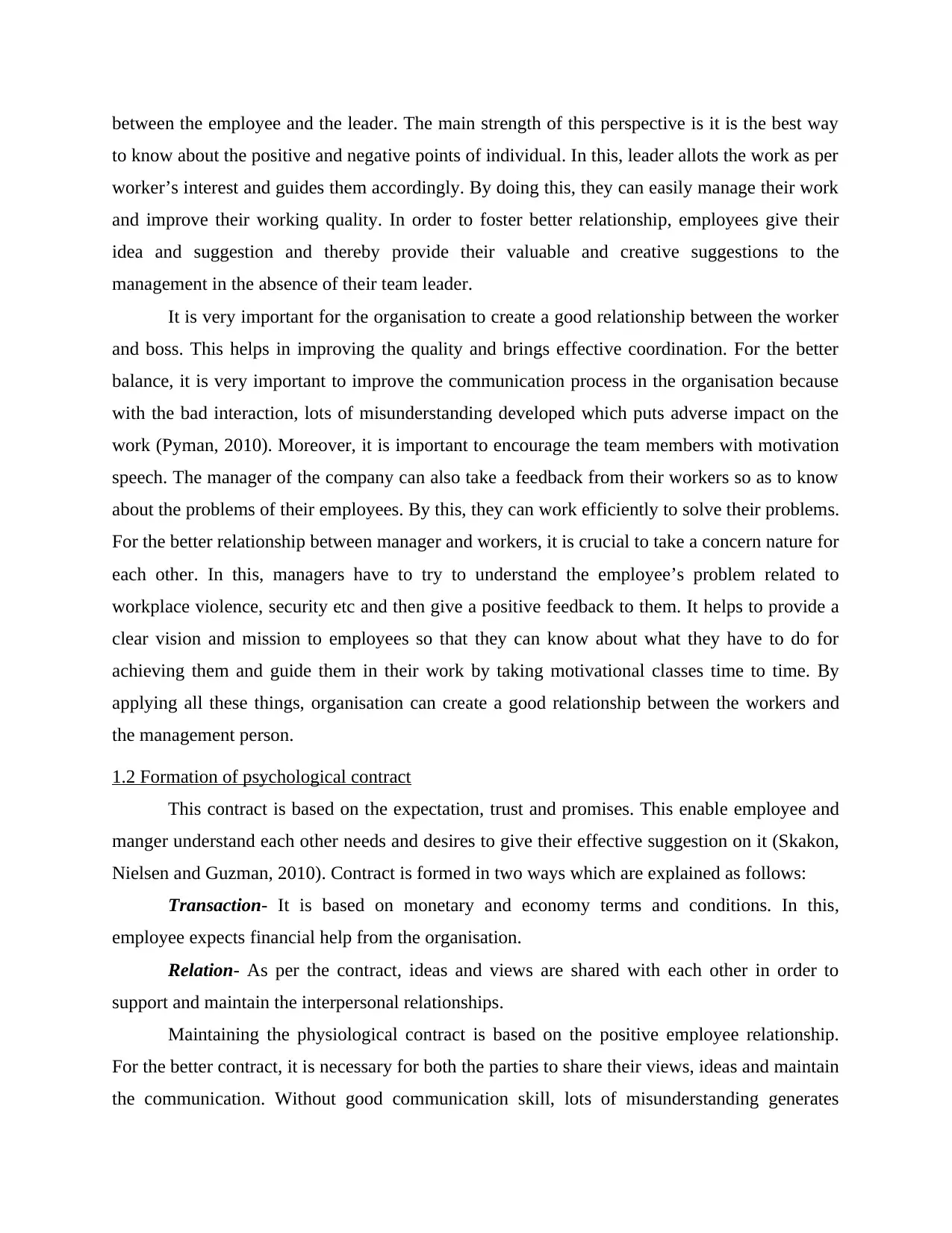
between the employee and the leader. The main strength of this perspective is it is the best way
to know about the positive and negative points of individual. In this, leader allots the work as per
worker’s interest and guides them accordingly. By doing this, they can easily manage their work
and improve their working quality. In order to foster better relationship, employees give their
idea and suggestion and thereby provide their valuable and creative suggestions to the
management in the absence of their team leader.
It is very important for the organisation to create a good relationship between the worker
and boss. This helps in improving the quality and brings effective coordination. For the better
balance, it is very important to improve the communication process in the organisation because
with the bad interaction, lots of misunderstanding developed which puts adverse impact on the
work (Pyman, 2010). Moreover, it is important to encourage the team members with motivation
speech. The manager of the company can also take a feedback from their workers so as to know
about the problems of their employees. By this, they can work efficiently to solve their problems.
For the better relationship between manager and workers, it is crucial to take a concern nature for
each other. In this, managers have to try to understand the employee’s problem related to
workplace violence, security etc and then give a positive feedback to them. It helps to provide a
clear vision and mission to employees so that they can know about what they have to do for
achieving them and guide them in their work by taking motivational classes time to time. By
applying all these things, organisation can create a good relationship between the workers and
the management person.
1.2 Formation of psychological contract
This contract is based on the expectation, trust and promises. This enable employee and
manger understand each other needs and desires to give their effective suggestion on it (Skakon,
Nielsen and Guzman, 2010). Contract is formed in two ways which are explained as follows:
Transaction- It is based on monetary and economy terms and conditions. In this,
employee expects financial help from the organisation.
Relation- As per the contract, ideas and views are shared with each other in order to
support and maintain the interpersonal relationships.
Maintaining the physiological contract is based on the positive employee relationship.
For the better contract, it is necessary for both the parties to share their views, ideas and maintain
the communication. Without good communication skill, lots of misunderstanding generates
to know about the positive and negative points of individual. In this, leader allots the work as per
worker’s interest and guides them accordingly. By doing this, they can easily manage their work
and improve their working quality. In order to foster better relationship, employees give their
idea and suggestion and thereby provide their valuable and creative suggestions to the
management in the absence of their team leader.
It is very important for the organisation to create a good relationship between the worker
and boss. This helps in improving the quality and brings effective coordination. For the better
balance, it is very important to improve the communication process in the organisation because
with the bad interaction, lots of misunderstanding developed which puts adverse impact on the
work (Pyman, 2010). Moreover, it is important to encourage the team members with motivation
speech. The manager of the company can also take a feedback from their workers so as to know
about the problems of their employees. By this, they can work efficiently to solve their problems.
For the better relationship between manager and workers, it is crucial to take a concern nature for
each other. In this, managers have to try to understand the employee’s problem related to
workplace violence, security etc and then give a positive feedback to them. It helps to provide a
clear vision and mission to employees so that they can know about what they have to do for
achieving them and guide them in their work by taking motivational classes time to time. By
applying all these things, organisation can create a good relationship between the workers and
the management person.
1.2 Formation of psychological contract
This contract is based on the expectation, trust and promises. This enable employee and
manger understand each other needs and desires to give their effective suggestion on it (Skakon,
Nielsen and Guzman, 2010). Contract is formed in two ways which are explained as follows:
Transaction- It is based on monetary and economy terms and conditions. In this,
employee expects financial help from the organisation.
Relation- As per the contract, ideas and views are shared with each other in order to
support and maintain the interpersonal relationships.
Maintaining the physiological contract is based on the positive employee relationship.
For the better contract, it is necessary for both the parties to share their views, ideas and maintain
the communication. Without good communication skill, lots of misunderstanding generates
Paraphrase This Document
Need a fresh take? Get an instant paraphrase of this document with our AI Paraphraser
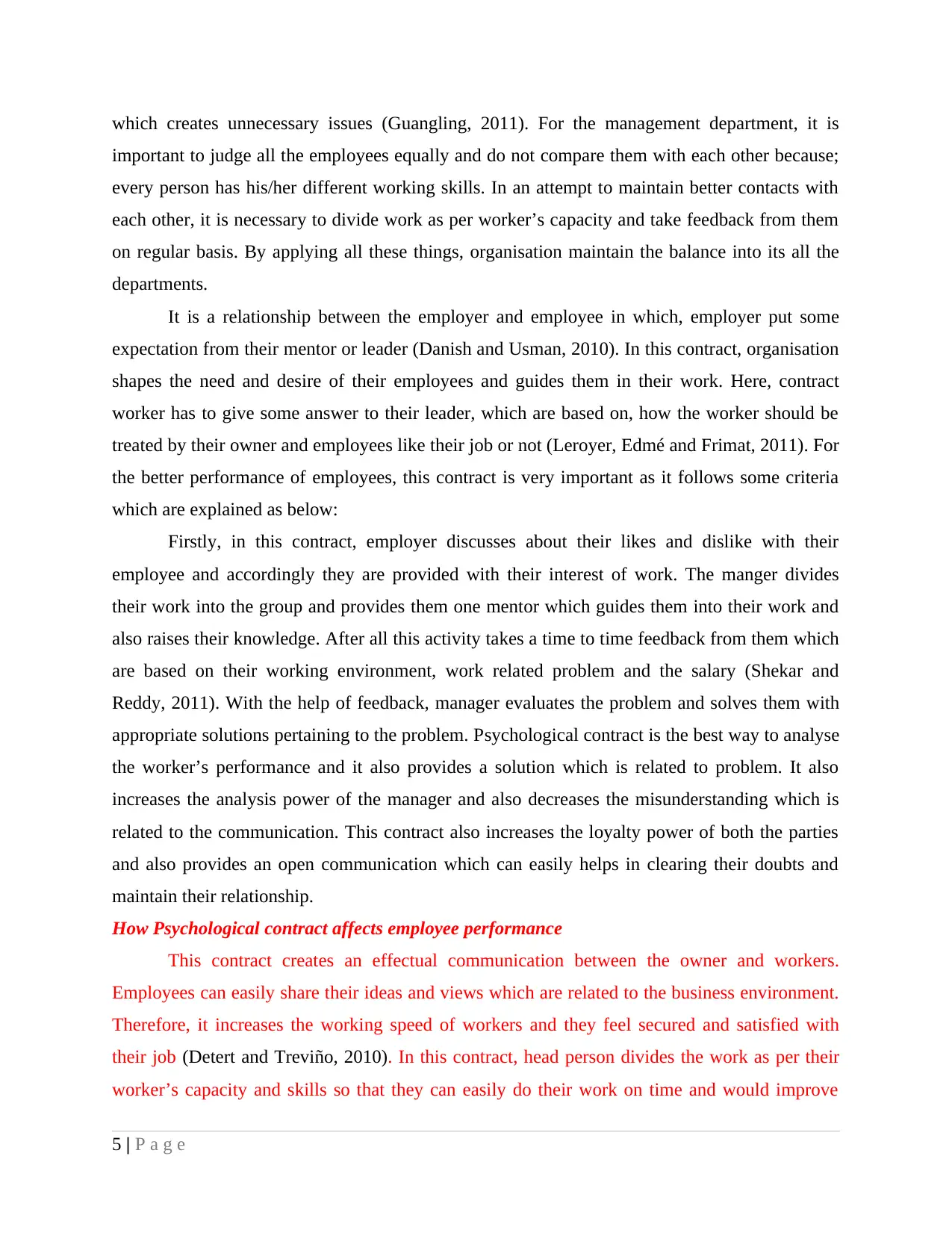
which creates unnecessary issues (Guangling, 2011). For the management department, it is
important to judge all the employees equally and do not compare them with each other because;
every person has his/her different working skills. In an attempt to maintain better contacts with
each other, it is necessary to divide work as per worker’s capacity and take feedback from them
on regular basis. By applying all these things, organisation maintain the balance into its all the
departments.
It is a relationship between the employer and employee in which, employer put some
expectation from their mentor or leader (Danish and Usman, 2010). In this contract, organisation
shapes the need and desire of their employees and guides them in their work. Here, contract
worker has to give some answer to their leader, which are based on, how the worker should be
treated by their owner and employees like their job or not (Leroyer, Edmé and Frimat, 2011). For
the better performance of employees, this contract is very important as it follows some criteria
which are explained as below:
Firstly, in this contract, employer discusses about their likes and dislike with their
employee and accordingly they are provided with their interest of work. The manger divides
their work into the group and provides them one mentor which guides them into their work and
also raises their knowledge. After all this activity takes a time to time feedback from them which
are based on their working environment, work related problem and the salary (Shekar and
Reddy, 2011). With the help of feedback, manager evaluates the problem and solves them with
appropriate solutions pertaining to the problem. Psychological contract is the best way to analyse
the worker’s performance and it also provides a solution which is related to problem. It also
increases the analysis power of the manager and also decreases the misunderstanding which is
related to the communication. This contract also increases the loyalty power of both the parties
and also provides an open communication which can easily helps in clearing their doubts and
maintain their relationship.
How Psychological contract affects employee performance
This contract creates an effectual communication between the owner and workers.
Employees can easily share their ideas and views which are related to the business environment.
Therefore, it increases the working speed of workers and they feel secured and satisfied with
their job (Detert and Treviño, 2010). In this contract, head person divides the work as per their
worker’s capacity and skills so that they can easily do their work on time and would improve
5 | P a g e
important to judge all the employees equally and do not compare them with each other because;
every person has his/her different working skills. In an attempt to maintain better contacts with
each other, it is necessary to divide work as per worker’s capacity and take feedback from them
on regular basis. By applying all these things, organisation maintain the balance into its all the
departments.
It is a relationship between the employer and employee in which, employer put some
expectation from their mentor or leader (Danish and Usman, 2010). In this contract, organisation
shapes the need and desire of their employees and guides them in their work. Here, contract
worker has to give some answer to their leader, which are based on, how the worker should be
treated by their owner and employees like their job or not (Leroyer, Edmé and Frimat, 2011). For
the better performance of employees, this contract is very important as it follows some criteria
which are explained as below:
Firstly, in this contract, employer discusses about their likes and dislike with their
employee and accordingly they are provided with their interest of work. The manger divides
their work into the group and provides them one mentor which guides them into their work and
also raises their knowledge. After all this activity takes a time to time feedback from them which
are based on their working environment, work related problem and the salary (Shekar and
Reddy, 2011). With the help of feedback, manager evaluates the problem and solves them with
appropriate solutions pertaining to the problem. Psychological contract is the best way to analyse
the worker’s performance and it also provides a solution which is related to problem. It also
increases the analysis power of the manager and also decreases the misunderstanding which is
related to the communication. This contract also increases the loyalty power of both the parties
and also provides an open communication which can easily helps in clearing their doubts and
maintain their relationship.
How Psychological contract affects employee performance
This contract creates an effectual communication between the owner and workers.
Employees can easily share their ideas and views which are related to the business environment.
Therefore, it increases the working speed of workers and they feel secured and satisfied with
their job (Detert and Treviño, 2010). In this contract, head person divides the work as per their
worker’s capacity and skills so that they can easily do their work on time and would improve
5 | P a g e
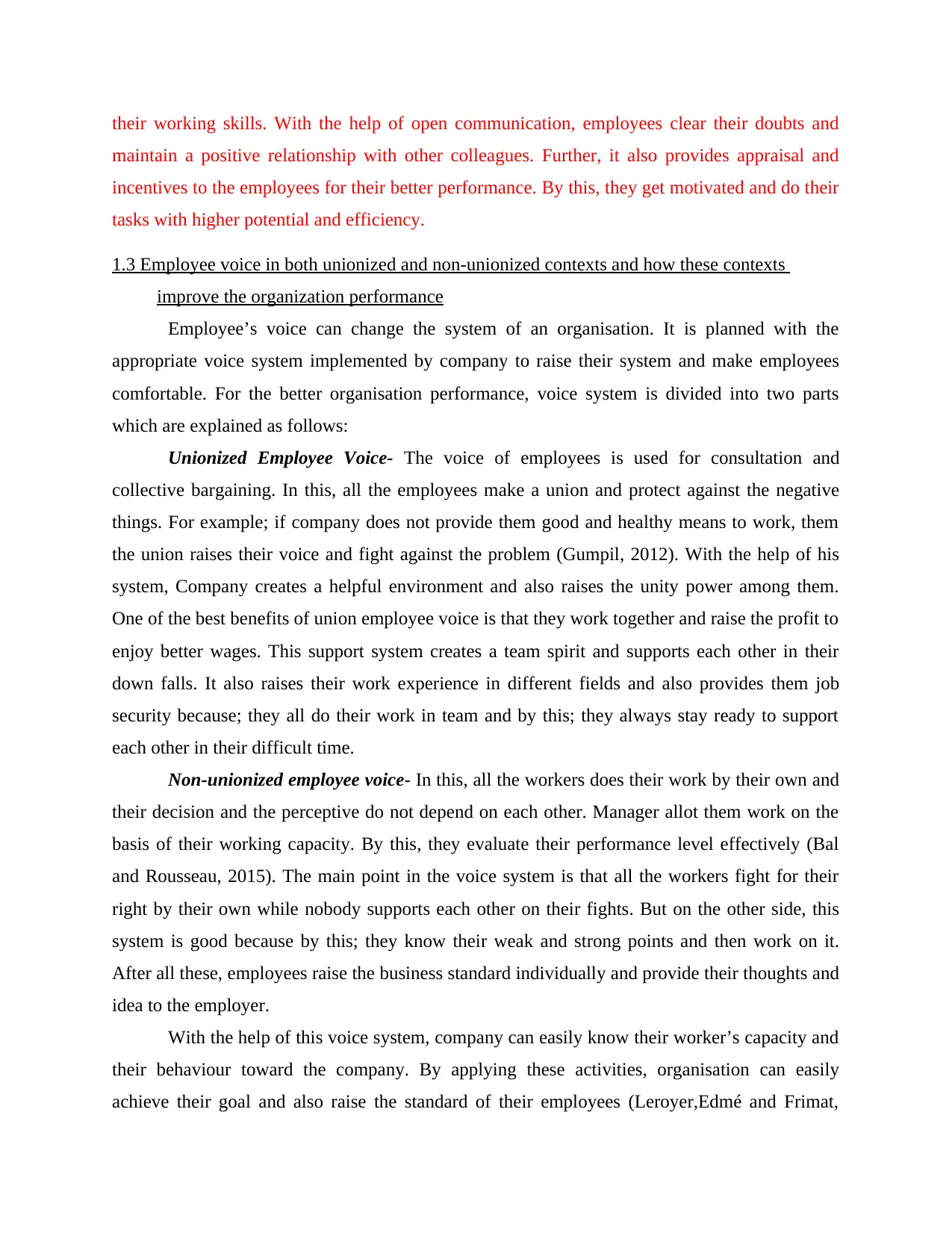
their working skills. With the help of open communication, employees clear their doubts and
maintain a positive relationship with other colleagues. Further, it also provides appraisal and
incentives to the employees for their better performance. By this, they get motivated and do their
tasks with higher potential and efficiency.
1.3 Employee voice in both unionized and non-unionized contexts and how these contexts
improve the organization performance
Employee’s voice can change the system of an organisation. It is planned with the
appropriate voice system implemented by company to raise their system and make employees
comfortable. For the better organisation performance, voice system is divided into two parts
which are explained as follows:
Unionized Employee Voice- The voice of employees is used for consultation and
collective bargaining. In this, all the employees make a union and protect against the negative
things. For example; if company does not provide them good and healthy means to work, them
the union raises their voice and fight against the problem (Gumpil, 2012). With the help of his
system, Company creates a helpful environment and also raises the unity power among them.
One of the best benefits of union employee voice is that they work together and raise the profit to
enjoy better wages. This support system creates a team spirit and supports each other in their
down falls. It also raises their work experience in different fields and also provides them job
security because; they all do their work in team and by this; they always stay ready to support
each other in their difficult time.
Non-unionized employee voice- In this, all the workers does their work by their own and
their decision and the perceptive do not depend on each other. Manager allot them work on the
basis of their working capacity. By this, they evaluate their performance level effectively (Bal
and Rousseau, 2015). The main point in the voice system is that all the workers fight for their
right by their own while nobody supports each other on their fights. But on the other side, this
system is good because by this; they know their weak and strong points and then work on it.
After all these, employees raise the business standard individually and provide their thoughts and
idea to the employer.
With the help of this voice system, company can easily know their worker’s capacity and
their behaviour toward the company. By applying these activities, organisation can easily
achieve their goal and also raise the standard of their employees (Leroyer,Edmé and Frimat,
maintain a positive relationship with other colleagues. Further, it also provides appraisal and
incentives to the employees for their better performance. By this, they get motivated and do their
tasks with higher potential and efficiency.
1.3 Employee voice in both unionized and non-unionized contexts and how these contexts
improve the organization performance
Employee’s voice can change the system of an organisation. It is planned with the
appropriate voice system implemented by company to raise their system and make employees
comfortable. For the better organisation performance, voice system is divided into two parts
which are explained as follows:
Unionized Employee Voice- The voice of employees is used for consultation and
collective bargaining. In this, all the employees make a union and protect against the negative
things. For example; if company does not provide them good and healthy means to work, them
the union raises their voice and fight against the problem (Gumpil, 2012). With the help of his
system, Company creates a helpful environment and also raises the unity power among them.
One of the best benefits of union employee voice is that they work together and raise the profit to
enjoy better wages. This support system creates a team spirit and supports each other in their
down falls. It also raises their work experience in different fields and also provides them job
security because; they all do their work in team and by this; they always stay ready to support
each other in their difficult time.
Non-unionized employee voice- In this, all the workers does their work by their own and
their decision and the perceptive do not depend on each other. Manager allot them work on the
basis of their working capacity. By this, they evaluate their performance level effectively (Bal
and Rousseau, 2015). The main point in the voice system is that all the workers fight for their
right by their own while nobody supports each other on their fights. But on the other side, this
system is good because by this; they know their weak and strong points and then work on it.
After all these, employees raise the business standard individually and provide their thoughts and
idea to the employer.
With the help of this voice system, company can easily know their worker’s capacity and
their behaviour toward the company. By applying these activities, organisation can easily
achieve their goal and also raise the standard of their employees (Leroyer,Edmé and Frimat,
⊘ This is a preview!⊘
Do you want full access?
Subscribe today to unlock all pages.

Trusted by 1+ million students worldwide
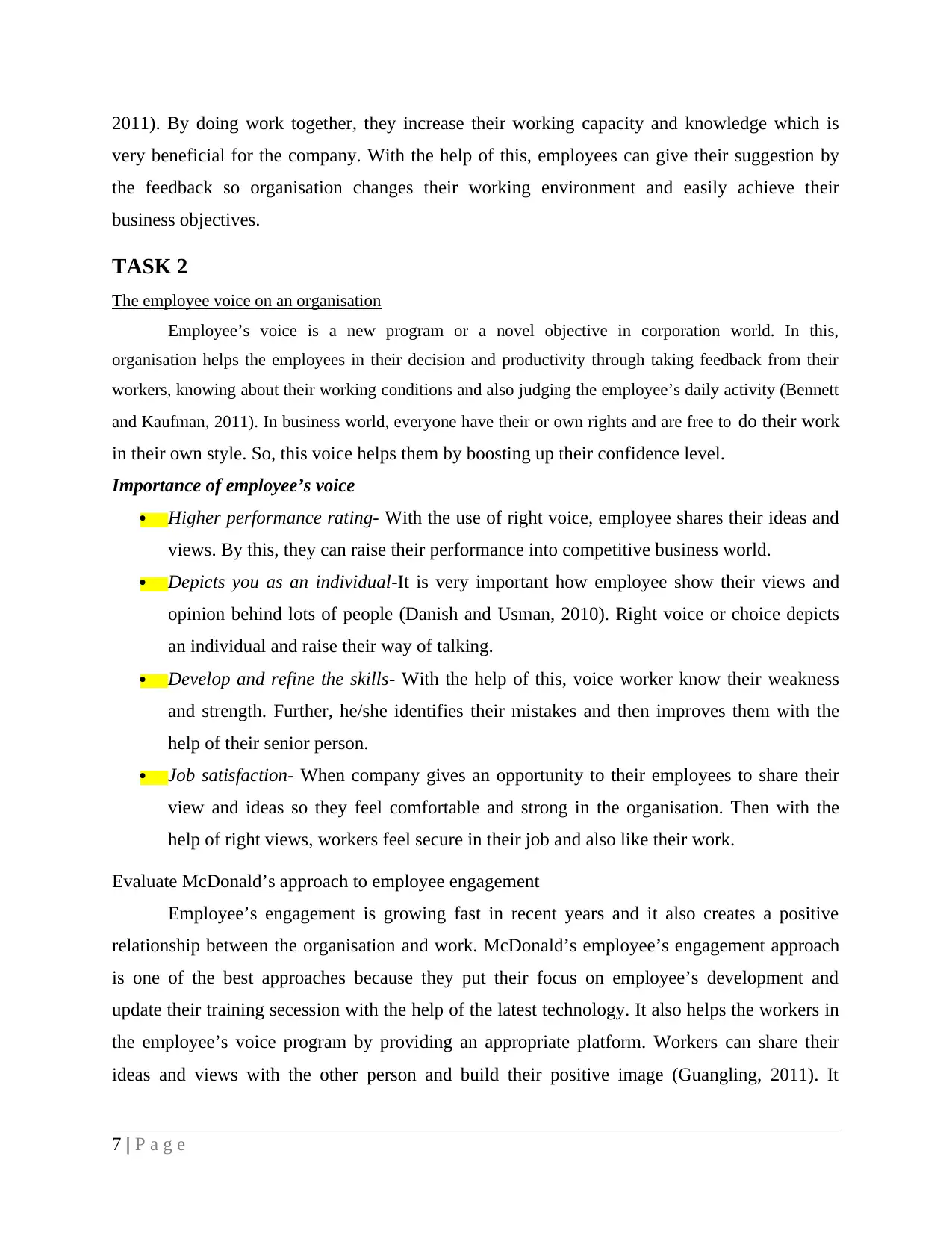
2011). By doing work together, they increase their working capacity and knowledge which is
very beneficial for the company. With the help of this, employees can give their suggestion by
the feedback so organisation changes their working environment and easily achieve their
business objectives.
TASK 2
The employee voice on an organisation
Employee’s voice is a new program or a novel objective in corporation world. In this,
organisation helps the employees in their decision and productivity through taking feedback from their
workers, knowing about their working conditions and also judging the employee’s daily activity (Bennett
and Kaufman, 2011). In business world, everyone have their or own rights and are free to do their work
in their own style. So, this voice helps them by boosting up their confidence level.
Importance of employee’s voice
Higher performance rating- With the use of right voice, employee shares their ideas and
views. By this, they can raise their performance into competitive business world.
Depicts you as an individual-It is very important how employee show their views and
opinion behind lots of people (Danish and Usman, 2010). Right voice or choice depicts
an individual and raise their way of talking.
Develop and refine the skills- With the help of this, voice worker know their weakness
and strength. Further, he/she identifies their mistakes and then improves them with the
help of their senior person.
Job satisfaction- When company gives an opportunity to their employees to share their
view and ideas so they feel comfortable and strong in the organisation. Then with the
help of right views, workers feel secure in their job and also like their work.
Evaluate McDonald’s approach to employee engagement
Employee’s engagement is growing fast in recent years and it also creates a positive
relationship between the organisation and work. McDonald’s employee’s engagement approach
is one of the best approaches because they put their focus on employee’s development and
update their training secession with the help of the latest technology. It also helps the workers in
the employee’s voice program by providing an appropriate platform. Workers can share their
ideas and views with the other person and build their positive image (Guangling, 2011). It
7 | P a g e
very beneficial for the company. With the help of this, employees can give their suggestion by
the feedback so organisation changes their working environment and easily achieve their
business objectives.
TASK 2
The employee voice on an organisation
Employee’s voice is a new program or a novel objective in corporation world. In this,
organisation helps the employees in their decision and productivity through taking feedback from their
workers, knowing about their working conditions and also judging the employee’s daily activity (Bennett
and Kaufman, 2011). In business world, everyone have their or own rights and are free to do their work
in their own style. So, this voice helps them by boosting up their confidence level.
Importance of employee’s voice
Higher performance rating- With the use of right voice, employee shares their ideas and
views. By this, they can raise their performance into competitive business world.
Depicts you as an individual-It is very important how employee show their views and
opinion behind lots of people (Danish and Usman, 2010). Right voice or choice depicts
an individual and raise their way of talking.
Develop and refine the skills- With the help of this, voice worker know their weakness
and strength. Further, he/she identifies their mistakes and then improves them with the
help of their senior person.
Job satisfaction- When company gives an opportunity to their employees to share their
view and ideas so they feel comfortable and strong in the organisation. Then with the
help of right views, workers feel secure in their job and also like their work.
Evaluate McDonald’s approach to employee engagement
Employee’s engagement is growing fast in recent years and it also creates a positive
relationship between the organisation and work. McDonald’s employee’s engagement approach
is one of the best approaches because they put their focus on employee’s development and
update their training secession with the help of the latest technology. It also helps the workers in
the employee’s voice program by providing an appropriate platform. Workers can share their
ideas and views with the other person and build their positive image (Guangling, 2011). It
7 | P a g e
Paraphrase This Document
Need a fresh take? Get an instant paraphrase of this document with our AI Paraphraser
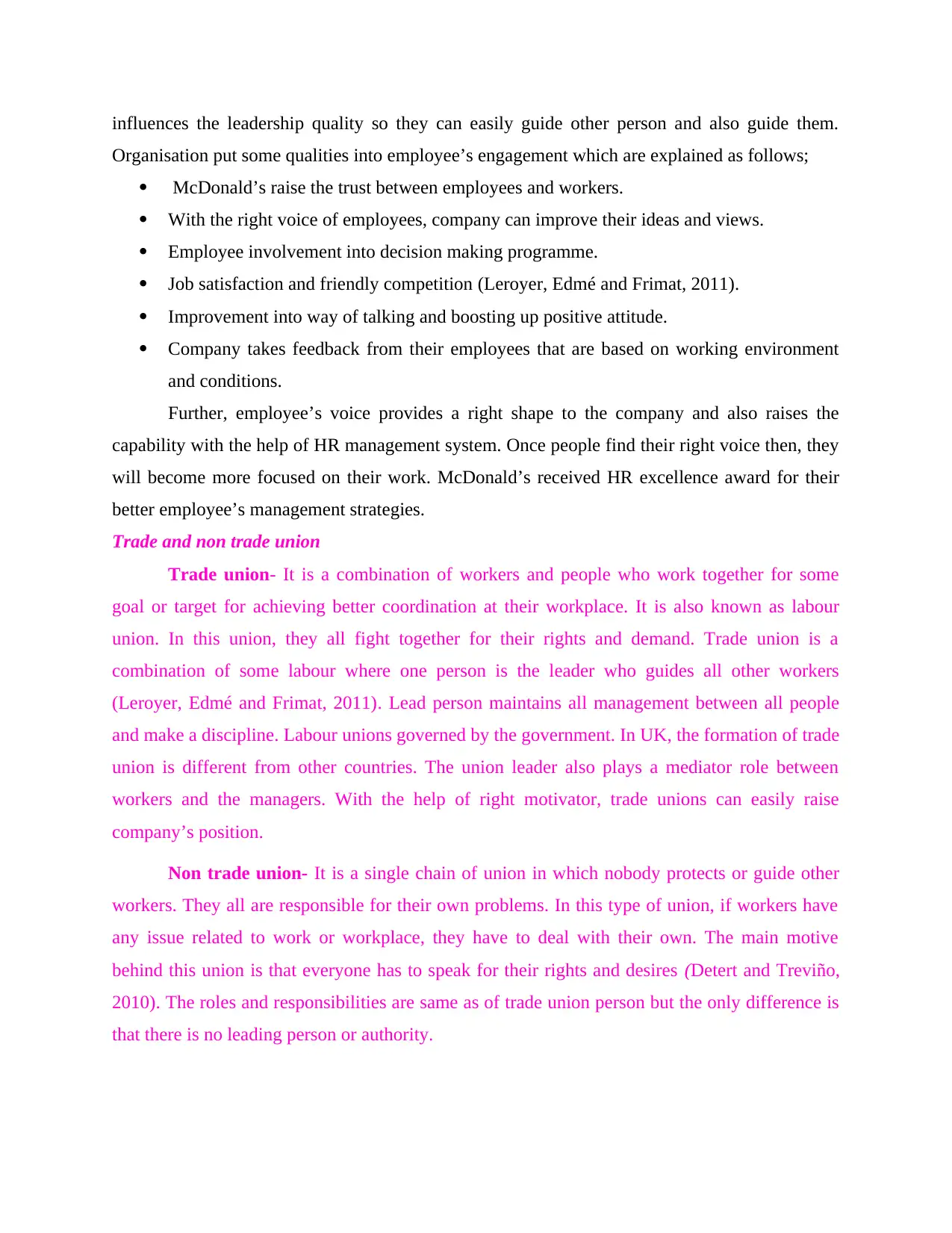
influences the leadership quality so they can easily guide other person and also guide them.
Organisation put some qualities into employee’s engagement which are explained as follows;
McDonald’s raise the trust between employees and workers.
With the right voice of employees, company can improve their ideas and views.
Employee involvement into decision making programme.
Job satisfaction and friendly competition (Leroyer, Edmé and Frimat, 2011).
Improvement into way of talking and boosting up positive attitude.
Company takes feedback from their employees that are based on working environment
and conditions.
Further, employee’s voice provides a right shape to the company and also raises the
capability with the help of HR management system. Once people find their right voice then, they
will become more focused on their work. McDonald’s received HR excellence award for their
better employee’s management strategies.
Trade and non trade union
Trade union- It is a combination of workers and people who work together for some
goal or target for achieving better coordination at their workplace. It is also known as labour
union. In this union, they all fight together for their rights and demand. Trade union is a
combination of some labour where one person is the leader who guides all other workers
(Leroyer, Edmé and Frimat, 2011). Lead person maintains all management between all people
and make a discipline. Labour unions governed by the government. In UK, the formation of trade
union is different from other countries. The union leader also plays a mediator role between
workers and the managers. With the help of right motivator, trade unions can easily raise
company’s position.
Non trade union- It is a single chain of union in which nobody protects or guide other
workers. They all are responsible for their own problems. In this type of union, if workers have
any issue related to work or workplace, they have to deal with their own. The main motive
behind this union is that everyone has to speak for their rights and desires (Detert and Treviño,
2010). The roles and responsibilities are same as of trade union person but the only difference is
that there is no leading person or authority.
Organisation put some qualities into employee’s engagement which are explained as follows;
McDonald’s raise the trust between employees and workers.
With the right voice of employees, company can improve their ideas and views.
Employee involvement into decision making programme.
Job satisfaction and friendly competition (Leroyer, Edmé and Frimat, 2011).
Improvement into way of talking and boosting up positive attitude.
Company takes feedback from their employees that are based on working environment
and conditions.
Further, employee’s voice provides a right shape to the company and also raises the
capability with the help of HR management system. Once people find their right voice then, they
will become more focused on their work. McDonald’s received HR excellence award for their
better employee’s management strategies.
Trade and non trade union
Trade union- It is a combination of workers and people who work together for some
goal or target for achieving better coordination at their workplace. It is also known as labour
union. In this union, they all fight together for their rights and demand. Trade union is a
combination of some labour where one person is the leader who guides all other workers
(Leroyer, Edmé and Frimat, 2011). Lead person maintains all management between all people
and make a discipline. Labour unions governed by the government. In UK, the formation of trade
union is different from other countries. The union leader also plays a mediator role between
workers and the managers. With the help of right motivator, trade unions can easily raise
company’s position.
Non trade union- It is a single chain of union in which nobody protects or guide other
workers. They all are responsible for their own problems. In this type of union, if workers have
any issue related to work or workplace, they have to deal with their own. The main motive
behind this union is that everyone has to speak for their rights and desires (Detert and Treviño,
2010). The roles and responsibilities are same as of trade union person but the only difference is
that there is no leading person or authority.
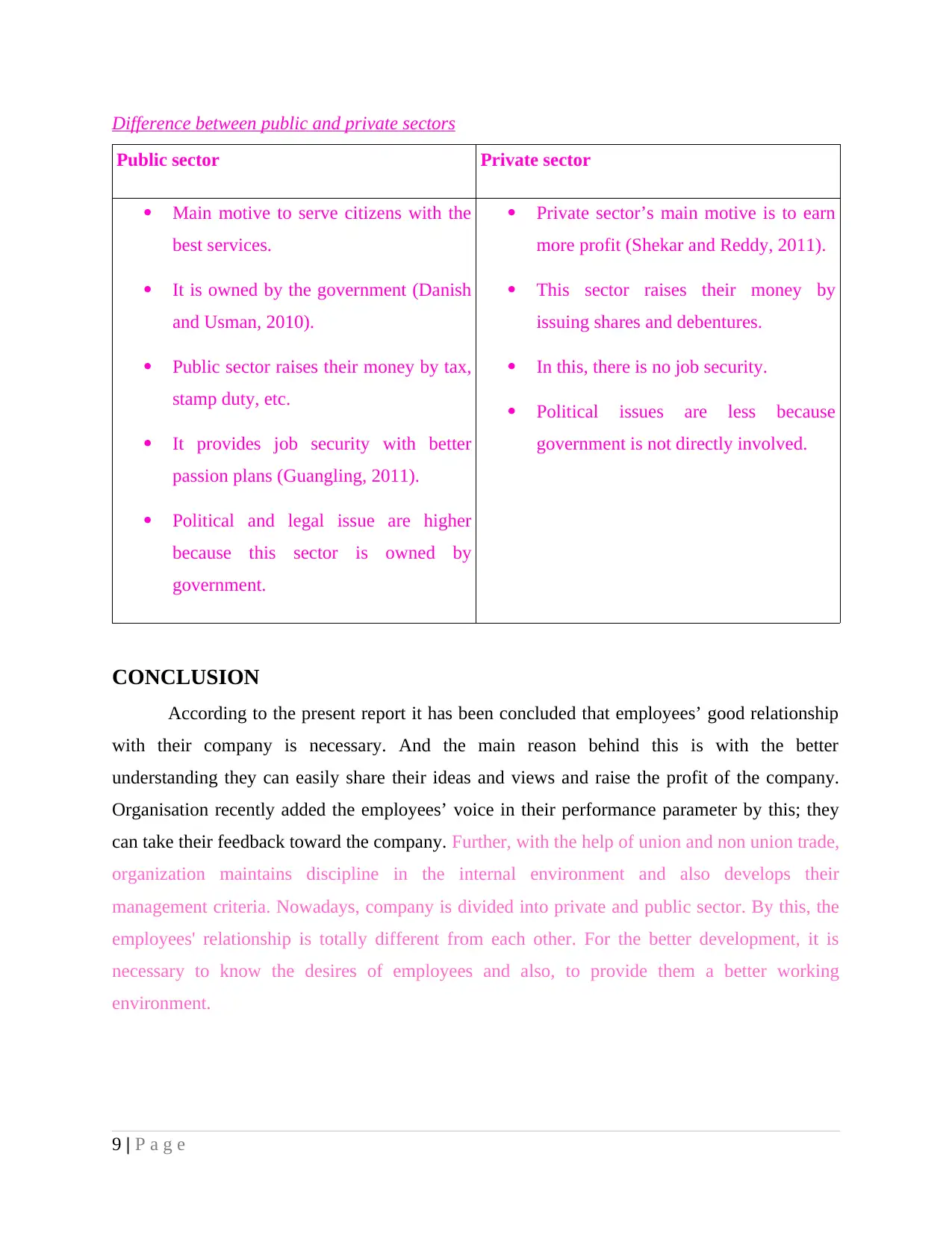
Difference between public and private sectors
Public sector Private sector
Main motive to serve citizens with the
best services.
It is owned by the government (Danish
and Usman, 2010).
Public sector raises their money by tax,
stamp duty, etc.
It provides job security with better
passion plans (Guangling, 2011).
Political and legal issue are higher
because this sector is owned by
government.
Private sector’s main motive is to earn
more profit (Shekar and Reddy, 2011).
This sector raises their money by
issuing shares and debentures.
In this, there is no job security.
Political issues are less because
government is not directly involved.
CONCLUSION
According to the present report it has been concluded that employees’ good relationship
with their company is necessary. And the main reason behind this is with the better
understanding they can easily share their ideas and views and raise the profit of the company.
Organisation recently added the employees’ voice in their performance parameter by this; they
can take their feedback toward the company. Further, with the help of union and non union trade,
organization maintains discipline in the internal environment and also develops their
management criteria. Nowadays, company is divided into private and public sector. By this, the
employees' relationship is totally different from each other. For the better development, it is
necessary to know the desires of employees and also, to provide them a better working
environment.
9 | P a g e
Public sector Private sector
Main motive to serve citizens with the
best services.
It is owned by the government (Danish
and Usman, 2010).
Public sector raises their money by tax,
stamp duty, etc.
It provides job security with better
passion plans (Guangling, 2011).
Political and legal issue are higher
because this sector is owned by
government.
Private sector’s main motive is to earn
more profit (Shekar and Reddy, 2011).
This sector raises their money by
issuing shares and debentures.
In this, there is no job security.
Political issues are less because
government is not directly involved.
CONCLUSION
According to the present report it has been concluded that employees’ good relationship
with their company is necessary. And the main reason behind this is with the better
understanding they can easily share their ideas and views and raise the profit of the company.
Organisation recently added the employees’ voice in their performance parameter by this; they
can take their feedback toward the company. Further, with the help of union and non union trade,
organization maintains discipline in the internal environment and also develops their
management criteria. Nowadays, company is divided into private and public sector. By this, the
employees' relationship is totally different from each other. For the better development, it is
necessary to know the desires of employees and also, to provide them a better working
environment.
9 | P a g e
⊘ This is a preview!⊘
Do you want full access?
Subscribe today to unlock all pages.

Trusted by 1+ million students worldwide
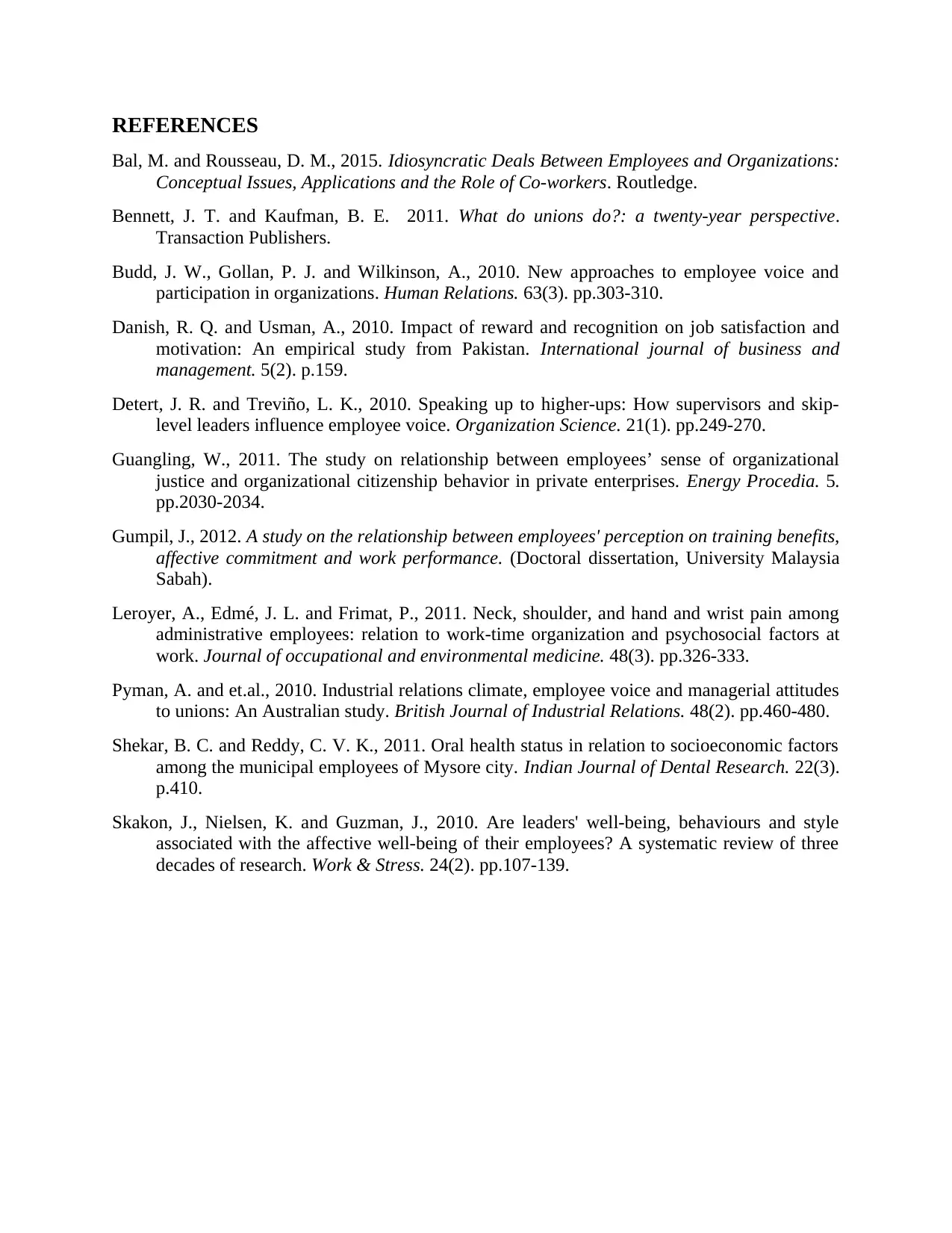
REFERENCES
Bal, M. and Rousseau, D. M., 2015. Idiosyncratic Deals Between Employees and Organizations:
Conceptual Issues, Applications and the Role of Co-workers. Routledge.
Bennett, J. T. and Kaufman, B. E. 2011. What do unions do?: a twenty-year perspective.
Transaction Publishers.
Budd, J. W., Gollan, P. J. and Wilkinson, A., 2010. New approaches to employee voice and
participation in organizations. Human Relations. 63(3). pp.303-310.
Danish, R. Q. and Usman, A., 2010. Impact of reward and recognition on job satisfaction and
motivation: An empirical study from Pakistan. International journal of business and
management. 5(2). p.159.
Detert, J. R. and Treviño, L. K., 2010. Speaking up to higher-ups: How supervisors and skip-
level leaders influence employee voice. Organization Science. 21(1). pp.249-270.
Guangling, W., 2011. The study on relationship between employees’ sense of organizational
justice and organizational citizenship behavior in private enterprises. Energy Procedia. 5.
pp.2030-2034.
Gumpil, J., 2012. A study on the relationship between employees' perception on training benefits,
affective commitment and work performance. (Doctoral dissertation, University Malaysia
Sabah).
Leroyer, A., Edmé, J. L. and Frimat, P., 2011. Neck, shoulder, and hand and wrist pain among
administrative employees: relation to work-time organization and psychosocial factors at
work. Journal of occupational and environmental medicine. 48(3). pp.326-333.
Pyman, A. and et.al., 2010. Industrial relations climate, employee voice and managerial attitudes
to unions: An Australian study. British Journal of Industrial Relations. 48(2). pp.460-480.
Shekar, B. C. and Reddy, C. V. K., 2011. Oral health status in relation to socioeconomic factors
among the municipal employees of Mysore city. Indian Journal of Dental Research. 22(3).
p.410.
Skakon, J., Nielsen, K. and Guzman, J., 2010. Are leaders' well-being, behaviours and style
associated with the affective well-being of their employees? A systematic review of three
decades of research. Work & Stress. 24(2). pp.107-139.
Bal, M. and Rousseau, D. M., 2015. Idiosyncratic Deals Between Employees and Organizations:
Conceptual Issues, Applications and the Role of Co-workers. Routledge.
Bennett, J. T. and Kaufman, B. E. 2011. What do unions do?: a twenty-year perspective.
Transaction Publishers.
Budd, J. W., Gollan, P. J. and Wilkinson, A., 2010. New approaches to employee voice and
participation in organizations. Human Relations. 63(3). pp.303-310.
Danish, R. Q. and Usman, A., 2010. Impact of reward and recognition on job satisfaction and
motivation: An empirical study from Pakistan. International journal of business and
management. 5(2). p.159.
Detert, J. R. and Treviño, L. K., 2010. Speaking up to higher-ups: How supervisors and skip-
level leaders influence employee voice. Organization Science. 21(1). pp.249-270.
Guangling, W., 2011. The study on relationship between employees’ sense of organizational
justice and organizational citizenship behavior in private enterprises. Energy Procedia. 5.
pp.2030-2034.
Gumpil, J., 2012. A study on the relationship between employees' perception on training benefits,
affective commitment and work performance. (Doctoral dissertation, University Malaysia
Sabah).
Leroyer, A., Edmé, J. L. and Frimat, P., 2011. Neck, shoulder, and hand and wrist pain among
administrative employees: relation to work-time organization and psychosocial factors at
work. Journal of occupational and environmental medicine. 48(3). pp.326-333.
Pyman, A. and et.al., 2010. Industrial relations climate, employee voice and managerial attitudes
to unions: An Australian study. British Journal of Industrial Relations. 48(2). pp.460-480.
Shekar, B. C. and Reddy, C. V. K., 2011. Oral health status in relation to socioeconomic factors
among the municipal employees of Mysore city. Indian Journal of Dental Research. 22(3).
p.410.
Skakon, J., Nielsen, K. and Guzman, J., 2010. Are leaders' well-being, behaviours and style
associated with the affective well-being of their employees? A systematic review of three
decades of research. Work & Stress. 24(2). pp.107-139.
1 out of 10
Related Documents
Your All-in-One AI-Powered Toolkit for Academic Success.
+13062052269
info@desklib.com
Available 24*7 on WhatsApp / Email
![[object Object]](/_next/static/media/star-bottom.7253800d.svg)
Unlock your academic potential
Copyright © 2020–2025 A2Z Services. All Rights Reserved. Developed and managed by ZUCOL.





